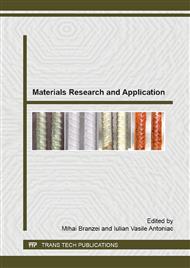p.68
p.76
p.81
p.86
p.92
p.100
p.112
p.121
p.129
Preparation and Characterization of Conductive Polymer Nanocomposites Based on Ethylene–Vinylacetate Copolymer (EVA) Reinforced with Expanded and Unexpanded Graphite
Abstract:
Recently polymer nanocomposites are used more and more frequently in industry due to the fact that the properties of the polymers can be altered to the specific requirements by the addition of particles and fibers of different properties, shapes. Polymers are poor thermal and electrical conductors, conductive fillers such as metallic powders, carbon black, graphite, are usually incorporated into polymer matrix to produce conducting composites. In this study composites were prepared using ethylenevinyl acetate (EVA) copolymer as matrix filled with two kinds of reinforcement graphite materials: untreated natural graphite (UG) and expanded graphite (EG). Composite samples up to 29.3 % graphite particle volumetric concentrations (50 % mass concentration) were prepared by the melt mixing process in a Brabender Plasticorder. Upon mixing, the EG particles originally 5μm to 6μm in size, exfoliates in the form of nanosheets having a few nanometer thickness; they have very big surface areas with high aspect ratio ranging between 20 and 250, as evidenced by TEM micrographs. From the experimental results it was deduced that the electrical conductivity was not only a function of filler concentration, but also strongly dependent on the graphite structure. The percolation concentration of the filler was found to be (15 to 17) vol% for micro-sized natural graphite, whereas the percolation concentration of the filler in nanocomposites filled with expanded graphite was much lower, about (5 to 6) vol%. The electrical conductivity of nanocomposites was also much higher than the electrical conductivity of composites filled with micro-sized filler at similar concentrations. Similarly, the values of the thermal diffusivity for the nanocomposites, EG-filled EVA, were significantly higher than the thermal diffusivity of the composites filled with micro-sized filler, UG-filled EVA, at similar concentrations. The effect of thermal cycling on the tensile behavior of EVA composites containing 4% and 15% of UG by mass and 6% and 15% of EG by mass were subjected to thermal cycling between-25 to +60 °C. Tension tests were conducted after thermal cycling for 50 and 100 cycles. Tensile strength remained practically unchanged after thermal cycling, while the Young modulus increased appreciably with the number of thermal cycle.
Info:
Periodical:
Pages:
92-99
Citation:
Online since:
July 2015
Authors:
Keywords:
Price:
Сopyright:
© 2015 Trans Tech Publications Ltd. All Rights Reserved
Share:
Citation:


